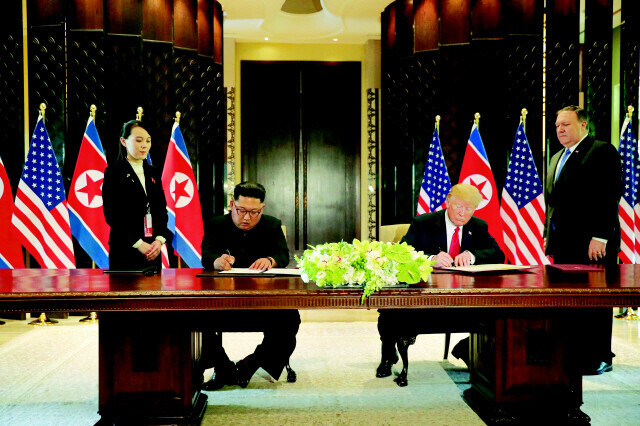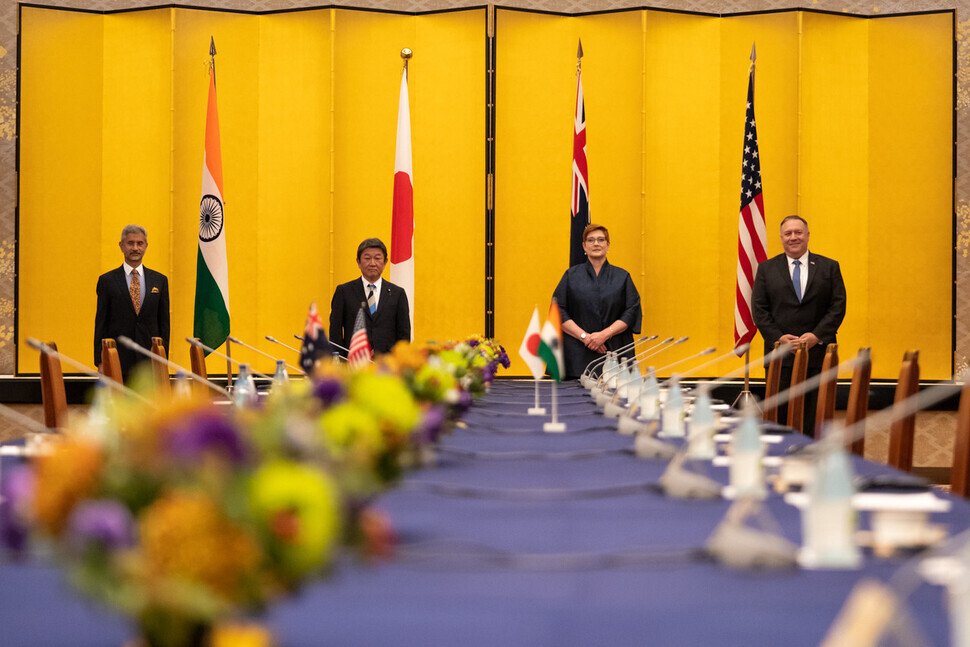hankyoreh
Links to other country sites 다른 나라 사이트 링크
S. Korea tried to orchestrate Kim Yo-jong’s US visit before presidential election, Japanese paper reports

Details are coming into focus about the diplomatic efforts made by the South Korean government to achieve an “October surprise” with a dramatic resumption of North Korea-US dialogue ahead of the US presidential election on Nov. 3. Seoul appears to have sought a breakthrough in the current impasse by orchestrating a large-scale “performance” involving a US visit by Kim Yo-jong and a declaration ending the Korean War to satisfy North Korea’s demands for regime security.
Japan’s Yomiuri Shimbun newspaper published an Oct. 7 article citing multiple sources connected with discussions between South Korea, the US, and Japan as saying that the Moon Jae-in administration attempted to broker a US visit by Workers’ Party of Korea (WPK) First Vice Director Kim Yo-jong ahead of the US presidential election in November. Initially, Seoul focused on bringing about a third North Korea-US summit as a way of nudging the two sides’ nuclear talks out of their deadlock. In the process, the idea of a US visit by Kim Yo-jong -- the younger sister of leader Kim Jong-un -- was raised, the newspaper reported.
The situation at the time was one where Kim Jong-un was unlikely to take any “diplomatic risks” after the blow from the breakdown of the North Korea-US summit in Hanoi in late February 2019. The South Korean government concluded that if Kim Yo-jong were to visit the US and meet with President Donald Trump, this would be a way of drawing major US media attention just ahead of the election and getting the ball rolling again for the stalled North Korea-US talks. In a Ministry of Foreign Affairs (MOFA) parliamentary audit at the National Assembly on Oct. 7, Minister of Foreign Affairs Kang Kyung-wha called the report “untrue.”
Kim Yo-jong hints at becoming Pyongyang’s communication channel with WashingtonBut a review of the actions of South and North Korean and US officials over the past three months makes it difficult to take Kang’s denial at face value. After North Korea’s surprise demolition of the inter-Korean joint liaison office in Kaesong last June left inter-Korean relations on the edge of a precipice, Moon attempted to turn the tide with a shakeup of his foreign affairs and national security lineup. The first “card” he played was a third North Korea-US summit. His remarks on June 30, when he said that “efforts toward North Korea-US dialogue need to be pursued once more before the US election,” came in the context of this push. In a statement on July 7, Kim Yo-jong strongly hinted that she would be serving in the future as Pyongyang’s window for communication with the US.
“I’m trying to personally obtain DVDs on US Independence Day events from now on, and I’ve also gotten approval from the Chairman for that,” she said at the time.

At this point, Seoul began focusing on developing an agenda to draw Pyongyang into the talks. The solution it came up with was an end-of-war declaration. In a previous statement, Kim Yo-jong insisted that the basic premise of negotiations between North Korea and the US needed to be revised from “denuclearization measures versus lifting of sanctions” to “withdrawal of hostility versus resumption of DPRK-US negotiations” -- where “withdrawal of hostility” between the two sides could be interpreted as referring to a declaration ending the Korean War.
US visits by South Korean officials ensued, including First Vice Foreign Minister Choi Jong-kun, National Security Office Second Deputy Director Kim Hyun-chong, and Special Representative for Korean Peninsula Peace and Security Affairs Lee Do-hoon. On Sept. 23, Moon raised the end-of-war declaration issue again in a speech before the UN General Assembly.
Both North Korea and the US appear to have shown some interest in the idea. After a Sept. 28 meeting with Lee Do-hoon in Washington, DC, US Deputy Secretary of State Stephen Biegun said the two had discussed “creative ideas” for denuclearization and the establishment of peace on the Korean Peninsula, calling on North Korea to participate as well. Kim Jong-un exchanged personal correspondence with Moon during the first half of September, and surprised many with a letter of sympathy to Trump on Oct. 3.
Pompeo’s cancellation of S. Korea visit indicates US’ prioritization of China issues over inter-Korean relationsBut the prospects for this “October surprise” quickly dimmed when a planned South Korea visit by US Secretary of State Mike Pompeo was canceled in the wake of Trump testing positive for COVID-19 on Oct. 2. The US seemed to send a particular message with its attendance at an Oct. 6 meeting in Tokyo of foreign ministers with the so-called “Quad” countries, with the aim of reining in China. This showed that the Trump administration’s focus ahead of the election is less on dialogue with North Korea than on containing China, which is likely to draw more support from US voters.
By Gil Yun-hyung, staff reporter
Please direct comments or questions to [english@hani.co.kr]
Editorial・opinion
![[Column] Season 2 of special prosecutor probe may be coming to Korea soon [Column] Season 2 of special prosecutor probe may be coming to Korea soon](https://flexible.img.hani.co.kr/flexible/normal/500/300/imgdb/original/2024/0426/3317141030699447.jpg) [Column] Season 2 of special prosecutor probe may be coming to Korea soon
[Column] Season 2 of special prosecutor probe may be coming to Korea soon![[Column] Park Geun-hye déjà vu in Yoon Suk-yeol [Column] Park Geun-hye déjà vu in Yoon Suk-yeol](https://flexible.img.hani.co.kr/flexible/normal/500/300/imgdb/original/2024/0424/651713945113788.jpg) [Column] Park Geun-hye déjà vu in Yoon Suk-yeol
[Column] Park Geun-hye déjà vu in Yoon Suk-yeol- [Editorial] New weight of N. Korea’s nuclear threats makes dialogue all the more urgent
- [Guest essay] The real reason Korea’s new right wants to dub Rhee a founding father
- [Column] ‘Choson’: Is it time we start referring to N. Korea in its own terms?
- [Editorial] Japan’s rewriting of history with Korea has gone too far
- [Column] The president’s questionable capacity for dialogue
- [Column] Are chaebol firms just pizza pies for families to divvy up as they please?
- [Column] Has Korea, too, crossed the Rubicon on China?
- [Correspondent’s column] In Japan’s alliance with US, echoes of its past alliances with UK
Most viewed articles
- 1AI is catching up with humans at a ‘shocking’ rate
- 2After election rout, Yoon’s left with 3 choices for dealing with the opposition
- 3Is Japan about to snatch control of Line messenger from Korea’s Naver?
- 4No good, very bad game for Korea puts it out of Olympics for first time since 1988
- 51 in 5 unwed Korean women want child-free life, study shows
- 6Will NewJeans end up collateral damage in internal feud at K-pop juggernaut Hybe?
- 7Korea’s 1.3% growth in Q1 signals ‘textbook’ return to growth, says government
- 8Marriages nosedived 40% over last 10 years in Korea, a factor in low birth rate
- 9[Editorial] Japan’s rewriting of history with Korea has gone too far
- 10Why Korea shouldn’t welcome Japan’s newly beefed up defense cooperation with US